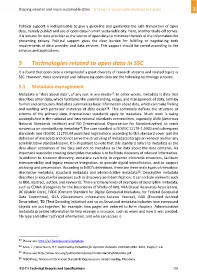Page 713 - Shaping smarter and more sustainable cities - Striving for sustainable development goals
P. 713
Political support is indispensable to give a guideline and guarantee the safe transaction of open
data, namely publish and use of open data in smart sustainable city. Here, another trade‐off comes.
It is natural for data provider as the source of open data to minimize the leak of the information for
preserving privacy. Political support gives the clear burden for fulfilling or negotiating both
requirements of data provider and data services. This support should be varied according to the
services and applications.
5 Technologies related to open data in SSC
It is found that open data is comprisedof a great diversity of research streams and related topics in
SSC. However, most connected and influencing open data are the following technology streams.
5.1 Metadata management
27
Metadata is "data about data", of any sort in any media . In other words, metadata is data that
describes other data, which facilitates the understanding, usage, and management of data, both by
human and computers. Metadata summarizes basic information about data, which can make finding
28
and working with particular instances of data easier . This commonly defines the structure or
schema of the primary data. International standards apply to metadata. Much work is being
accomplished in the national and international standards communities, especially ANSI (American
National Standards Institute) and ISO (International Organization for Standardization) to reach
29
consensus on standardizing metadata .The core standard is ISO/IEC 11179‐1:2004 and subsequent
standards (see ISO/IEC 11179).All published registrations according to this standard cover just the
definition of metadata and do not serve the structuring of metadata storage or retrieval neither any
administrative standardization. It is important to note that this standard refers to metadata as the
data about containers of the data and not to metadata as the data about the data contents. An
important reason for creating descriptive metadata is to facilitate discovery of relevant information.
In addition to resource discovery, metadata can help to organize electronic resources, facilitate
interoperability and legacy resource integration, to provide digital identification, and to support
archiving and preservation. According to NISO's definitions, there are three main types of metadata:
30
descriptive metadata, structural metadata and administrative metadata . Descriptive metadata
describes a resource for purposes such as discovery and identification. It can include elements such
as title, abstract, author, and keywords. There are many kinds of examples of descriptive metadata,
such as CDWA (Categories for the Description of Works of Art), VRA (Visual Resources Association),
DC (Dublin Core), FGDC (Content Standard for Digital Geospatial Metadata, for Federal Geospatial
Data Committee), GILS (Government Information Locator Service), EAD (Encoded Archival
Description), TEI (Text Encoding Initiative) and so on.Structural metadata indicates how compound
objects are put together, for example, how pages are ordered to form chapters. Administrative
metadata provides information to help manage a resource, such as when and how it was created,
file type and other technical information, and who can access it.
____________________
27 Please see: http://en.factolex.com/metadata.
28 Mize, J.; Habermann, R.T. Automating metadata for dynamic datasets. OCEANS 2010. 2010, Page(s): 1‐6.
29 Please see:http://www.niso.org/publications/press/UnderstandingMetadata.pdf.
30 NISO Press, National Information Standards Organization. Understanding Metadata.
ITU‐T's Technical Reports and Specifications 703

